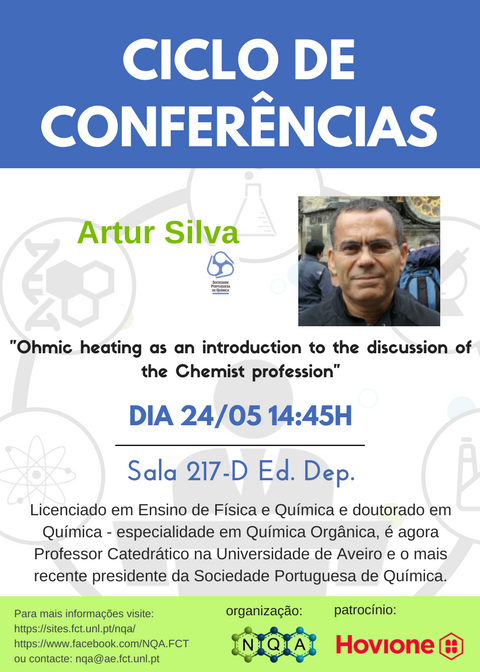5ª Conferência - Dr. Artur Silva
May 23, 2017
Boas,
Trouxemos o Professor Peter Atkins, mas o ciclo de conferências não fica por aqui. Voltamos já nesta quarta-feira com a presença do Presidente da Sociedade Portuguesa da Química, o Professor Dr. Artur Silva.

"One of the key goals in modern organic chemistry is the development of efficient synthetic routes leading to target compounds, under sustainable conditions, fulfilling green chemistry requirements. The reactions should preferably be facile and fast, and the resulting products should be easily isolated and purified, while saving time and energy. One strategy to achieve such goals is the development of alternative and more efficient heating technologies.
Ohmic heating, also known as direct Joule heating, is an advanced thermal processing method, in which the medium to be heated behaves as an electrical ohmic heater and is heated by passing an AC electrical current through it. The heat is generated in situ and dissipated directly in the medium with very high efficiency (> 90%) by Joule effect, eliminating the heat-transfer step from the surroundings to the medium by means of temperature gradients or hot surfaces (hot plate, heat mantle).[1,2]
Ohmic heating is mainly used in the food industry to rapidly increase the temperature for either cooking or sterilization purposes. Its use in chemical synthesis, in the heating of chemical reactors, is an emerging concept whose development started a few years ago with the design and construction of the first ohmic heating reactor (Patent PT 105908), within a project led by scientists at QOPNA, University of Aveiro, in collaboration with scientists from the Universities of Porto and Minho [1-3]. This reactor was already efficiently used in several organic transformations (Diels-Alder reactions, N-alkylations, nucleophilic substitutions, C-C cross coupling reactions, sequential reactions, indium-promoted reductive eliminations and dehalogenations and multicomponent reactions.[2-7] The reactions were faster, the yields and selectivities were higher, when compared to the results found in classical and microwave heating conditions, and the products were easily isolated and purified. It was shown that ohmic heating is an outstanding heating process and a high energy-efficient alternative way of heating chemical reactions, especially in aqueous media. Future research is necessary to investigate the thermal behaviour during heating and to fully understand the phenomena involved in this process.
The development of this heating reactor, that was then used to heat chemical transformations, it is a task not typical of a Chemist. This will be the starting point to discuss the profession of a Chemist.
Acknowledgements: thanks are due to the University of Aveiro and Fundação para a Ciência e Tecnologia
(FCT) for financial support to QOPNA (FCT UID/QUI/00062/2013) through national founds and where applicable co-financed by FEDER, within the PT2020 partnership agreement.
[1] V. L. M. Silva, A. M. S. Silva, L. M. N. B. F. Santos, A. M. G. Silva, J. Pinto, R. Enes, J. A. S. Cavaleiro, A. A. M. O. S. Vicente, J. A. C. Teixeira, A. Morais, J. C. S. Costa, Portuguese Patent 105908, September 27, 2011.
[2] J. Pinto, V. L. M. Silva, A. M. G. Silva, A. M. S. Silva, J. C. S. Costa, L. M. N. B. F. Santos, R. Enes, J. A. S. Cavaleiro, A. A. M. O. S. Vicente, J. A. C. Teixeira, Green Chem. 2013, 15, 970-975.
[3] V. L. M. Silva, L. M. N. B. F. Santos, A. M. S. Silva, Chem. Eur. J. 2017, 23, 1-14.
[4] J. Pinto, V. L. M. Silva, A. M. G. Silva, L. M. N. B. F. Santos, A. M. S. Silva, J. Org. Chem. 2015, 80, 6649-6659.
[5] J. Pinto, V. L. M. Silva, L. M. N. B. F. Santos, A. M. S. Silva, Eur. J. Org. Chem. 2016, 2888-2896.
[6] M. F. C. Cardoso, A. T. P. C. Gomes, V. L. M. Silva, A. M. S. Silva, M. G. P. M. S. Neves, F. C. da Silva, V. F. Ferreira, J. A. S. Cavaleiro, RSC Adv. 2015, 5, 66192-66199.
[7] R. G. Soengas, V. L. M. Silva, J. Pinto, H. Rodríguez-Solla, A. M. S. Silva, Eur. J. Org. Chem. 2016, 99- 107."

